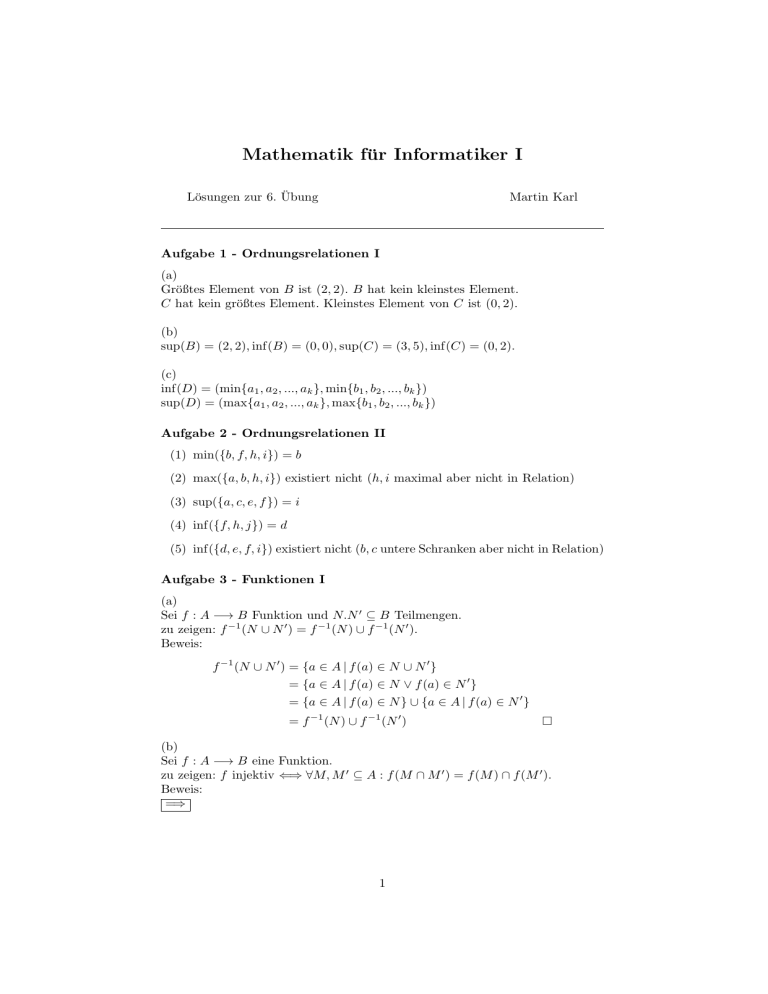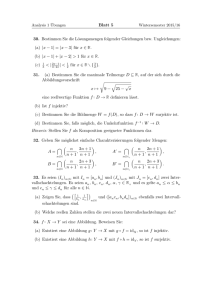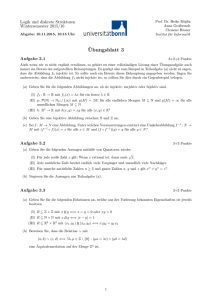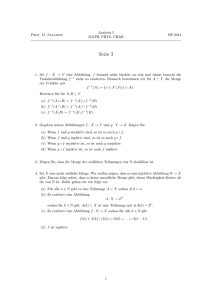Mathematik für Informatiker I
Werbung

Mathematik für Informatiker I
Lösungen zur 6. Übung
Martin Karl
Aufgabe 1 - Ordnungsrelationen I
(a)
Größtes Element von B ist (2, 2). B hat kein kleinstes Element.
C hat kein größtes Element. Kleinstes Element von C ist (0, 2).
(b)
sup(B) = (2, 2), inf(B) = (0, 0), sup(C) = (3, 5), inf(C) = (0, 2).
(c)
inf(D) = (min{a1 , a2 , ..., ak }, min{b1 , b2 , ..., bk })
sup(D) = (max{a1 , a2 , ..., ak }, max{b1 , b2 , ..., bk })
Aufgabe 2 - Ordnungsrelationen II
(1) min({b, f, h, i}) = b
(2) max({a, b, h, i}) existiert nicht (h, i maximal aber nicht in Relation)
(3) sup({a, c, e, f }) = i
(4) inf({f, h, j}) = d
(5) inf({d, e, f, i}) existiert nicht (b, c untere Schranken aber nicht in Relation)
Aufgabe 3 - Funktionen I
(a)
Sei f : A −→ B Funktion und N.N 0 ⊆ B Teilmengen.
zu zeigen: f −1 (N ∪ N 0 ) = f −1 (N ) ∪ f −1 (N 0 ).
Beweis:
f −1 (N ∪ N 0 ) = {a ∈ A | f (a) ∈ N ∪ N 0 }
= {a ∈ A | f (a) ∈ N ∨ f (a) ∈ N 0 }
= {a ∈ A | f (a) ∈ N } ∪ {a ∈ A | f (a) ∈ N 0 }
= f −1 (N ) ∪ f −1 (N 0 )
(b)
Sei f : A −→ B eine Funktion.
zu zeigen: f injektiv ⇐⇒ ∀M, M 0 ⊆ A : f (M ∩ M 0 ) = f (M ) ∩ f (M 0 ).
Beweis:
=⇒
1
Sei f injektiv und seien M, M 0 ⊆ A beliebig gewählt. Zeige zwei Inklusionen:
⊆
f (M ∩ M 0 ) = {b ∈ B | ∃a ∈ M ∩ M 0 : f (a) = b}
⊆ {b ∈ B | ∃a ∈ M : f (a) = b ∧ ∃a0 ∈ M 0 : f (a0 ) = b}
= {b ∈ B | ∃a ∈ M : f (a) = b} ∩ {b ∈ B | ∃a ∈ M 0 : f (a) = b}
= f (M ) ∩ f (M 0 )
⊇
Sei b ∈ f (M ) ∩ f (M 0 ), dann existieren a ∈ M, a0 ∈ M 0 mit f (a) = f (a0 ) = b.
Weil f injektiv ist, muss gelten, dass a = a0 , also liegt a auch in M ∩ M 0 .
Demzufolge gilt auch b ∈ f (M ∩ M 0 ).
⇐=
Gelte ∀M, M 0 ⊆ A : f (M ∩ M 0 ) = f (M ) ∩ f (M 0 ).
Angenommen f ist nicht injketiv, dann existieren a1 6= a2 mit f (a1 ) = f (a2 ).
Wähle M = {a1 } und M 0 = {a2 }. Es gilt:
M ∩ M 0 = ∅ 6= f (M ) ∩ f (M 0 ) = {f (a1 )} Widerspruch zu Voraussetzung, also
f injektiv.
Aufgabe 4 - Funktionen II
(1)
f ◦h : R −→ R hat die Zuordnungsvorschrift f ◦h(x) = f (h(x)) = f (x, x2 ) = x3 .
f ◦ h ist injektiv, da x1 6= x2 −→ x31 6= x32 .
√
√ 3
√
f ◦ h ist surjektiv, da x ∈ R das Urbild 3 x hat (f ( 3 x) = 3 x = x).
f ◦ h injektiv und surjektiv also bijektiv.
(3)
h ◦ f : R × R −→ R × R hat die Zuordnungsvorschrift h ◦ f (x, y) = h(f (x, y)) =
h(xy) = (xy, x2 y 2 ).
h◦f ist nicht injektiv, da (x1 , y1 ) = (0, −1) 6= (0, 1) = (x2 , y2 ) aber h◦f (0, −1) =
(0, 0) = h ◦ f (0, 1).
h ◦ f ist nicht surjektiv, da (0, 1) kein Urbild (x, y) hat. Ist die erste Koordinate
des Bildes Null, so muss x oder y gleich Null sein, damit ist aber auch die zweite
Koordinate des Bildes gleich Null.
h ◦ f nicht injektiv und nicht surjektiv also auch nicht bijektiv.
2


